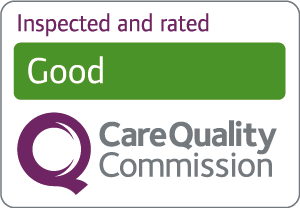
March is Ovarian Cancer Awareness Month and Mr Michael Davis, one of our Consultant Gynaecologists at New Victoria Hospital, guides you through the most common symptoms that might be a sign of ovarian cancer. Paying attention to changes or persisting pain in your body is vital to receive prompt examinations and treatment.
The sad truth about ovarian cancer
Ovarian cancer develops from an abnormal cell growth in or on the ovaries.
It accounts for 4% of all new cases of cancer among women and its incidence is highest between the ages of 60 and 80. However, it starts to rise steadily at 40 years old.
Although there are some risk factors and some symptoms you can pay attention to, the sad truth about ovarian cancer is that early detection is very challenging, compared to most other cancers.
Risk factors
There are a number of risk factors for ovarian cancer that can make you more vigilant and seek help sooner. However, having risk factors doesn’t mean you will definitely develop ovarian cancer.
Age
The incidence of ovarian cancer grows with age. It increases over the age of 65, but women over 50 are considered at higher risk of developing ovarian cancer.
Inherited genes mutation
15-20% of ovarian cancers are related to alteration in BRCA1 and BRCA2 genes, as well as a small number of other gene abnormalities. A family history of ovarian cancer increases the risk, without knowing the gene status.
History of cancer
If you have been previously diagnosed with breast or bowel cancer, especially at a younger age, and if the cancer was related to faulty BRCA1 and BRCA2 genes, your risk for ovarian cancer is higher.
Smoking and diet
Smoking and alcohol consumption, a high BMI and poor diet are considered risk factors for all types of cancers.
Other conditions
If you suffer from certain conditions such as endometriosis or diabetes, your risk of developing ovarian cancer might be greater, according to some studies.
How is ovarian cancer diagnosed
Initial examinations that are usually suggested after you refer symptoms can be:
- Pelvic exam – your Gynaecologist checks your vulva, cervix, uterus, ovaries and Fallopian tubes, with the use of the speculum and an internal digital examination. Masses can be found during the pelvic exam, but further examination is needed to identify the type of cells. Masses found in postmenopausal women are more likely to be cancerous, whereas in younger women are more likely to be benign.
- Ultrasound, transvaginal and transabdominal scan – by inserting an ultrasound probe into the vagina and onto the abdomen, the uterus, the Fallopian tubes and the ovaries can be checked to look for the presence of any mass. The ultrasound exam can’t tell if a mass is benign or cancerous, and further tests are needed to examine the cells. Most masses found with the scan exams are benign.
- CA125 and HE4 – These specific blood tests looks at the levels of the CA125 and HE4 proteins, which could be indicators of ovarian cancer. Further tests are usually needed before a precise diagnosis can be made. High levels of these proteins can also be due to endometriosis or other inflammatory conditions in the womb. These markers can be used to check if the cancer is regressing in women who have already been diagnosed with ovarian cancer and are under therapy.
- CT and/or MRI scans – these are further tests that will be undertaken to look at the spread of disease, and whether it would be suitable for an operation to treat it or not.
A diagnosis can only be made certain by examining tissue samples taken from your growth and looked at under the microscope. The tissue may be removed at the time of the operation or by a special biopsy under X-ray or ultrasound scan guidance.
Sometimes it is difficult to assess the situation and your Gynaecologist may recommend a laparoscopy, a surgical procedure to look inside your abdominal cavity and take more biopsies.
Laparoscopy can help diagnose ovarian cancer
Laparoscopy is an operation to look inside the abdominal cavity with a telescope using keyhole surgical techniques. It can be occasionally used to aid with the diagnosis of ovarian cancer, but often is used to remove ovarian cysts which are thought unlikely to be malignant. The tissue removed is always sent to the laboratory to be assessed.
Laparoscopy is usually done as a day case. This may be followed by major surgery at a later date if thought appropriate.
Why you should pay attention to small symptoms
Ovarian cancer is often diagnosed at a late stage because there are currently no screening tests available to identify pre cancer stages or early ovarian cancer disease, in the same way that it is done for breast cancer with mammograms or cervical cancer with the smear test for HPV.
For this reason, paying attention to small changes in your body and symptoms that persist for a few weeks, is important to detect a potential tumour as early as possible.
Some of the symptoms you should pay attention to are:
- Constipation, bloating, heartburn or upset stomach
- Difficulty eating or feeling full quickly
- Pelvic or abdominal pain, even during sex
- Menstrual changes
- Needing to urinate urgently or often
- Fatigue
- Back pain
If you experience any of these symptoms for over two weeks, you should talk with your GP, who will assess your symptoms and refer you to other specialists for further examinations.
However, if you are highly concerned about pain in your lower womb or other symptoms, you can see a Consultant Gynaecologist privately.
The latest DNA studies are trying to identify diagnostic biomarkers for early detection of ovarian cancer, that hopefully will be available for future generations. Until then, being aware of risk factors and monitoring small symptoms are the only way to spot signs of this type of cancer.
Early detection, when cancer has not spread to other organs, does help to save your life.
The survival rate for women diagnosed with stage 1 ovarian cancer is 90% in England, whereas it drops significantly with later-stage cancers.
Target Ovarian Cancer have recently launched their It’s Time to Take Ovar campaign to demand a greater involvement of the UK government in making proactive steps towards early diagnosis for ovarian cancer.
If you are diagnosed with ovarian cancer
If the biopsy confirms that the mass found are malignant, an appointment will be made for you to see a Gynaecologist with an interest in gynaecological cancer, and your case with scans and pathology results will be reviewed at a multidisciplinary team meeting to decide the best option of treatment for your individual case.
Sometimes surgery can be recommended as first line treatment, or you may be advised to have chemotherapy first and then surgery.
Hysterectomy
The operation will be a full hysterectomy, removal of the womb, tubes and ovaries as well as any other tumour that can be resected. The surgeon will also take other biopsies to see if the cancer has spread to sites that are not obviously involved.
If fertility preservation is an issue then this needs to be discussed with your doctors, who may well take advice from fertility experts. Sometimes it is possible to have fertility preserving treatment, but this would be evaluated on an individual basis.
A diagnosis of ovarian cancer is distressing and can be more difficult to accept for you as a woman since it involves your reproductive system. It can often be seen as a deprivation of your femininity, especially at a younger age.
Your Gynaecologist and Oncologist will always offer clinical and psychological support and discuss options and treatment plans with you after diagnosis.
If you would like to see one of our Consultant Gynaecologists at New Victoria Hospital, you can make an appointment by calling 020 8949 9020 or completing our booking form online.












